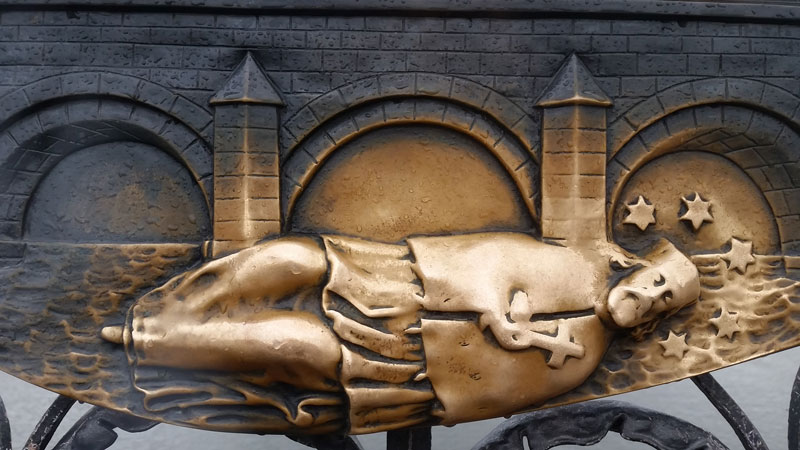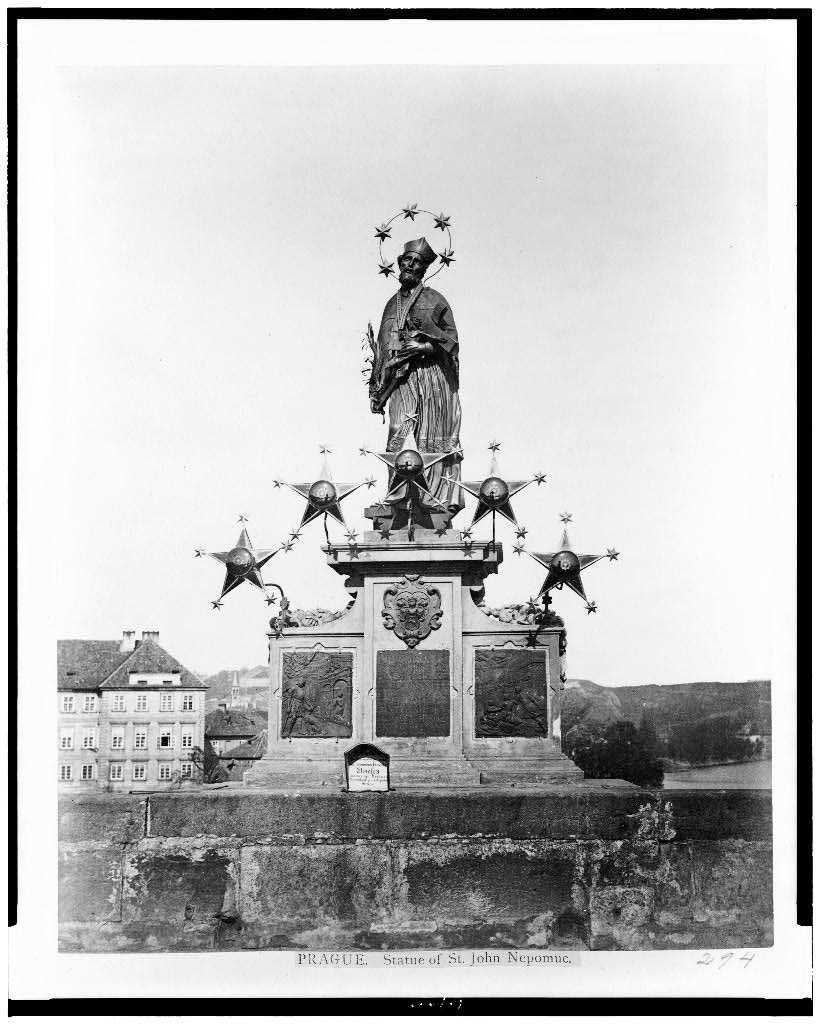Jan Nepomuk
You’ll see his statue in every published guide but there are other things to look for and understand. This post will give a brief timeline and background of Jan Nepomuk so you know how he came to die but mostly it’s about the icons on the Charles Bridge and how to recognise a Jan Nepomuk figure. Plus you’ll see how that famous statue on the Charles Bridge has changed over the years.

The Background
Born in the 1340s in Central Bohemia at a place called Pomuk, later this town merged with a neighbouring town and so the name changed to Nepomuk. As was a popular naming feature at the time he would not be known by his family name, he would simply be known as Jan coming from Nepomuk (Jan Nepomuk). By 1385 he is a noted religious figure in the court of Wenceslas IV.
The Role of Jan Nepomuk
The dates are hard to pin down but in 1389 he had become the confessor to the queen of the time. This would have been Sophia of Bavaria which would have made her something around 13 years old at the time of her marriage to Wenceslas IV and either 16 or 17 at the time of the death of Jan Nepomuk.
Date of Death
In some records the date of death of Jan Nepomuk is 1383. This was probably a mis-print because other records clearly show the Jan Nepomuk was alive in 1389 because, as mentioned above, he was named as confessor for the young queen Sophia.
Most records indicate that Jan Nepomuk died in 1393. There were other political things going on at that time and it’s likely that Jan Nepomuk became a pawn in a larger issue. Either way, as he refused to tell the King the confessions of his wife, this was used as an excuse to have him tortured and killed. The first recorded figure on the bridge was the Holy Crucifix and Calvary from 1361 but Jan Nepomuk was the first statue erected in 1683 and remains the only saint on the bridge made of metal (the others are sandstone).
The Jan Nepomuk Statue in 1860

You can immediately tell a Jan Nepomuk statue by the 5 stars around the head and the palm leaf (sign of a martyr). Sometimes you see an angel with a finger up to the lips (he did not break the seal of silence) but we don’t have that here. Note that in 1860 there were 5 large stars on the pedestal and the stars around the head were also larger. They were still there in 1890 Flood when you see pictures of the Charles Bridge after the flood damage.
The Jan Nepomuk Statue 1996


Here’s a picture I took in 1996. Years later I got an email from someone saying that I had a picture of the statue without the shiny dog. There are two brass plaques on the pedestal, the one on the right has a scene of what is supposed to be Queen Sophia on the riverside seeing Jan Nepomuk being thrown from the Charles Bridge into the river (detail pictured further down) having not revealed her confession.
On the other plaque your eye is drawn to an imperial guard stroking a dog. To the right of the guard you can just see the confessional box and the queen on her knees making a confession. The dog has no literal historical meaning but you could interpret faithfulness, loyalty and trust into it. It seems that over the years so many people have tried to touch the scene of him being thrown (they think it’s good luck) that not everybody could get to it so people started touching the dog. Now both are shiny but neither offer any good luck.
The Jan Nepomuk Statue Today


Well he’s a lot greener than he was in 1996 and in fact because he’s made of a metal alloy, he’s the only green statue on the Charles Bridge (the other saints are sandstone). Also note the shiny plaques on both sides. Standing in front of the statue and facing it, walk two lamp posts to your right to find the cross.
The 5-Star Cross
Pictured further above was the scene of Jan Nepomuk being thrown from the Charles Bridge to drown in the river. Legend has it that as he hit the water, 5 stars were seen to come from the water. The exact point where it was believed he was thrown from was marked by the unique Jan Nepomuk 5-star cross. Around 2015 this was embellished with an ornate wrought ironwork frame.

Tourists think that they have to touch the figure so it has become shiny (pictured above and detail at the top of this post). Czechs will only touch the cross mounted on the wall and make a wish which, legend has it, will come true within a year.
Something Related or a Few Minutes Away
Memorials – Holy Crucifix and Calvary
Attraction – The Iconic Charles Bridge
Art and Culture – Charles Bridge Portrait Artists
Services – Prague River Cruise Review
Films and Videos – Prague and Linkin Park
Films and Videos – Mission Impossible 1996
